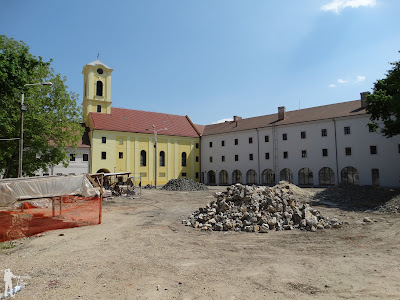Inima orașului din punct de vedere istoric, Cetatea Oradea este un obiectiv care nu trebuie ocolit. Ea se află la capătul străzii Independenței, lângă parcul 1 Decembrie.
Historically the heart of the city, Oradea Fortress is not to be avoided. It is found at the end of Independenței street, next to December 1st Park.
Historically the heart of the city, Oradea Fortress is not to be avoided. It is found at the end of Independenței street, next to December 1st Park.
Fondată de Regele Ladislau I al Ungariei (1077 - 1095), a fost menționată prima dată în 1241 (sub numele latin Varadinum), când i se făceau reparații grabnice în vederea atacului iminent al tătarilor. Totuși, nu era cetatea pe care o vedem astăzi, aceasta fiind ridicată în secolul 17 în formă bastionară.
Acel secol a fost unul zbuciumat pentru cetate:
În anul 1600, cetatea era stăpânită de Mihai Viteazul, care a trecut pe aici în drum spre Praga.
În anul 1660, otomanii cuceresc cetatea, Oradea devenind pentru 32 de ani pașalâc.
În anul 1692 cetatea este cucerită de Habsburgi, care îi dau forma de astăzi.
(imaginea se găsește în turnul primăriei)
Founded by King Ladislaus I of Hugary (1077 - 1095), it was mentioned for the first time in 1241 (under the name Varadinum), when it was hastily repaired for in imminent Tartar attack. However, it was not the fortress we see today, which was built in the 17th century in Vauban style.
Founded by King Ladislaus I of Hugary (1077 - 1095), it was mentioned for the first time in 1241 (under the name Varadinum), when it was hastily repaired for in imminent Tartar attack. However, it was not the fortress we see today, which was built in the 17th century in Vauban style.
După ce până la Revoluție cetatea a rămas obiectiv militar, ea a fost progresiv redată orașului ca obiectiv turistic. Accesul se face prin poarta de vest a cetății.
Until the 1989 Revolution, the fortress retained military functions. Later, it was progressively given back to the city as a tourist landmark. Visitors can enter through its west gate.
Until the 1989 Revolution, the fortress retained military functions. Later, it was progressively given back to the city as a tourist landmark. Visitors can enter through its west gate.
Din fericire, în ultimii ani cetatea a fost restaurată, unele lucrări fiind încă în curs piațeta centrală.
Fortunately, in the last years, the fortress was restored, and it was still undergoing restoration works when I visited it.
Aleile, bastioanele și drumurile de strajă sunt bine restaurate și consolidate. Cetatea numără cinci bastioane: bastionul ciunt, bastionul aurit, bastionul roșu, bastionul crăișorul și cel mai mare, bastionul Bethlen.
The alleys, the bastions and the sentry paths are well restored and consilidated. The fortress has five bastions: the stunted bastion, the golden bastion, the red bastion, the princely baston and the largest one - the Bethlen bastion.
The alleys, the bastions and the sentry paths are well restored and consilidated. The fortress has five bastions: the stunted bastion, the golden bastion, the red bastion, the princely baston and the largest one - the Bethlen bastion.
Partea din spate a cetății, spre poarta de est, este ultima asupra căreia trebuie să se intervină.
The back of the fortress, towards the eastern gate, is the last portion to work on.
The back of the fortress, towards the eastern gate, is the last portion to work on.
Vedere de pe zidurile din dreptul porții de est.
View from the walls of the eastern gate.
View from the walls of the eastern gate.
Diavolul stă în detalii: burlanele din cupru (!!!) sunt înscripționate cu conturul cetății.
The devil is in the details: copper water drains marked with the outlines of the fortress.
The devil is in the details: copper water drains marked with the outlines of the fortress.
La fel și capacele de canalizare. / Same thing with the sewerage system covers.
Am remarcat faptul că restaurarea cetății este pe alocuri stridentă, nu există patină. / The restoration is too flashy in some areas, lacking a patina.
În acea zi, compensa însă un pic pentru atmosferă această motocicletă de epocă (cred că este o Dnepr).
That day I saw a Dnipro motorcycle, which added to the historical atmosphere.
În bastionul ciunt a fost amenajat un teatru de vară. De menționat că cetatea adăpostește Facultatea de Arte Vizuale a Universității Oradea.
A summer theater was set up in the stunted bastion. The fortress also houses the Visual Arts Faculty of Oradea University.
A summer theater was set up in the stunted bastion. The fortress also houses the Visual Arts Faculty of Oradea University.
Biserica din centrul cetății datează din 1777. / The church in the center of the fortress dates back to 1777.
vechea clădire a administrației militare și a vămii / the old building of the military administration and customs
marginea zidului de apărare, cu drumul de strajă / the edge of the wall, with the sentry path
barăcile ofițerilor, restaurate și curând refuncționalizate / the officer barracks, restored and soon to be occupied with modern use
În curtea cetății există o dovadă că Cetatea Oradea vă iubește!
In the fortress courtyard, there is proof that Oradea loves you!
In the fortress courtyard, there is proof that Oradea loves you!

















Comentarii
Trimiteți un comentariu